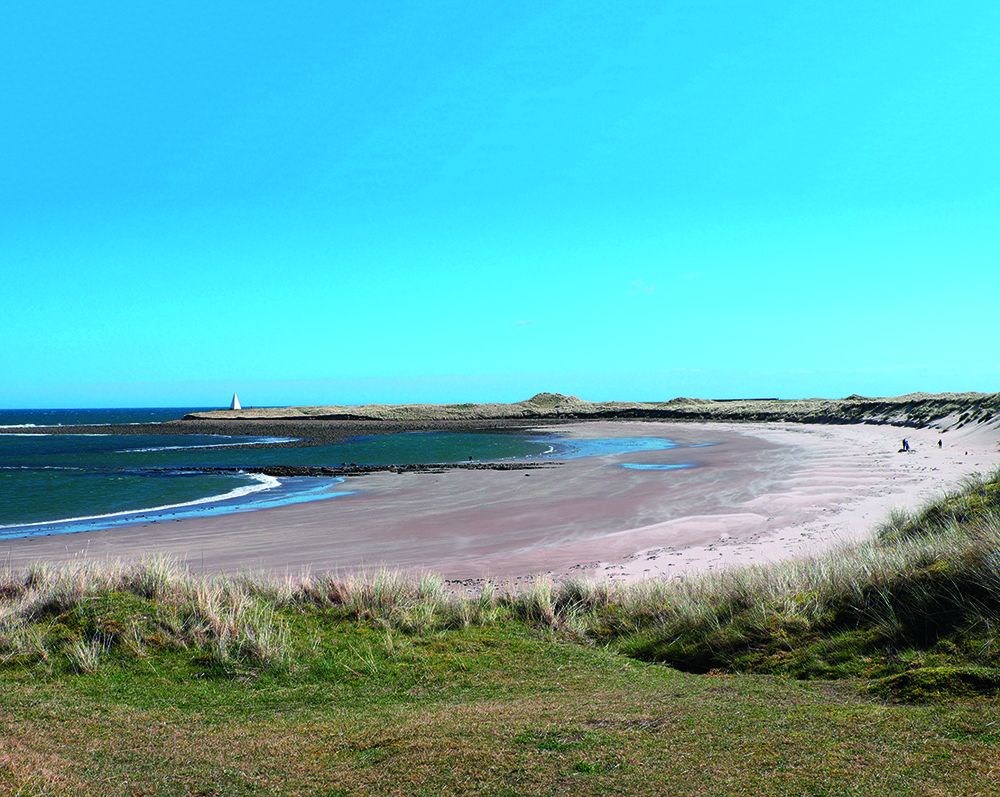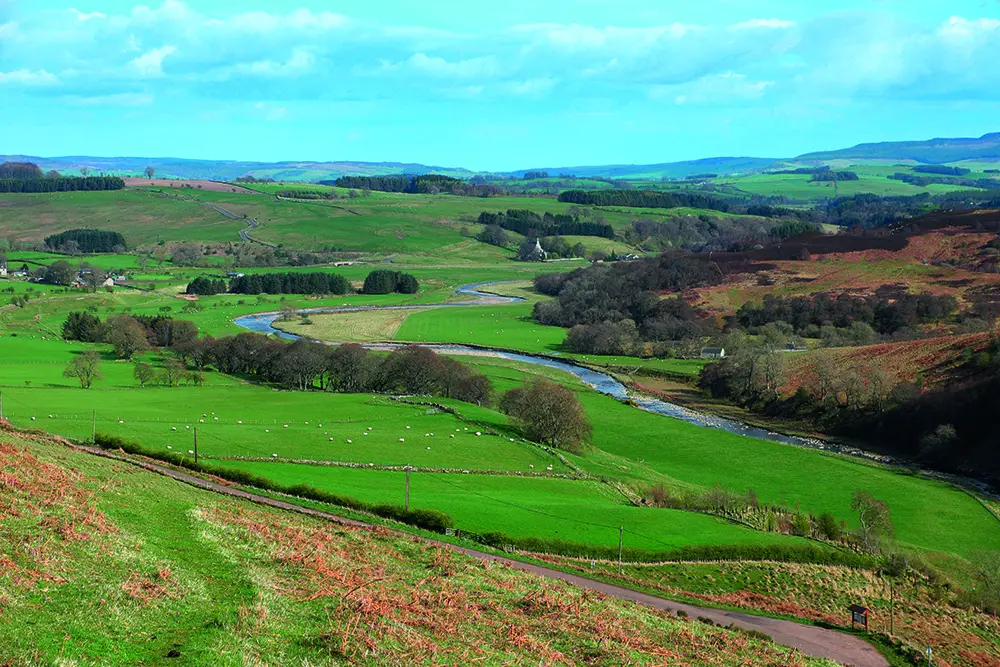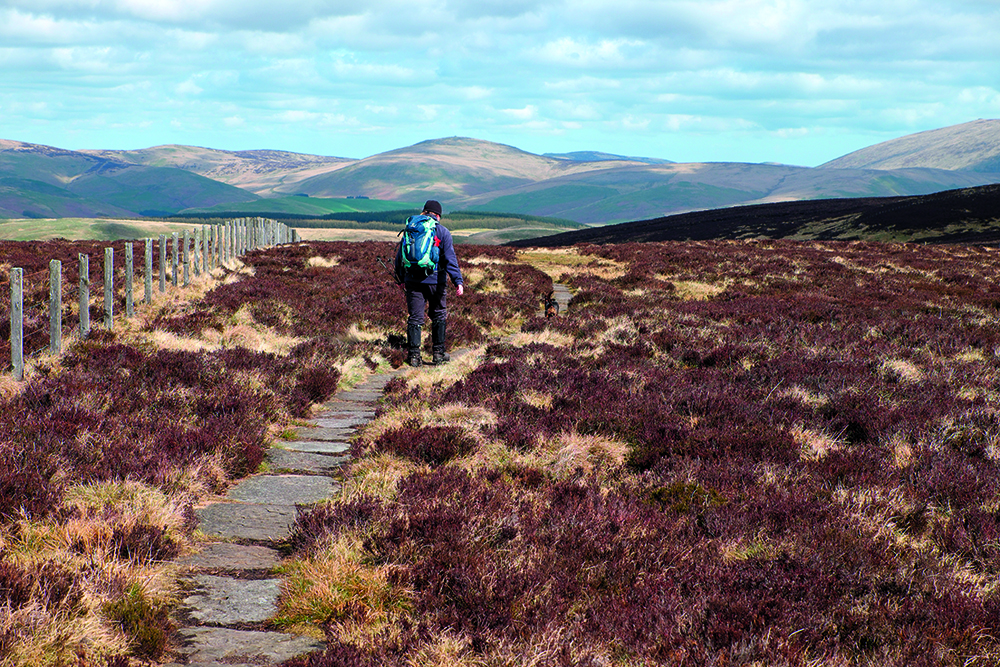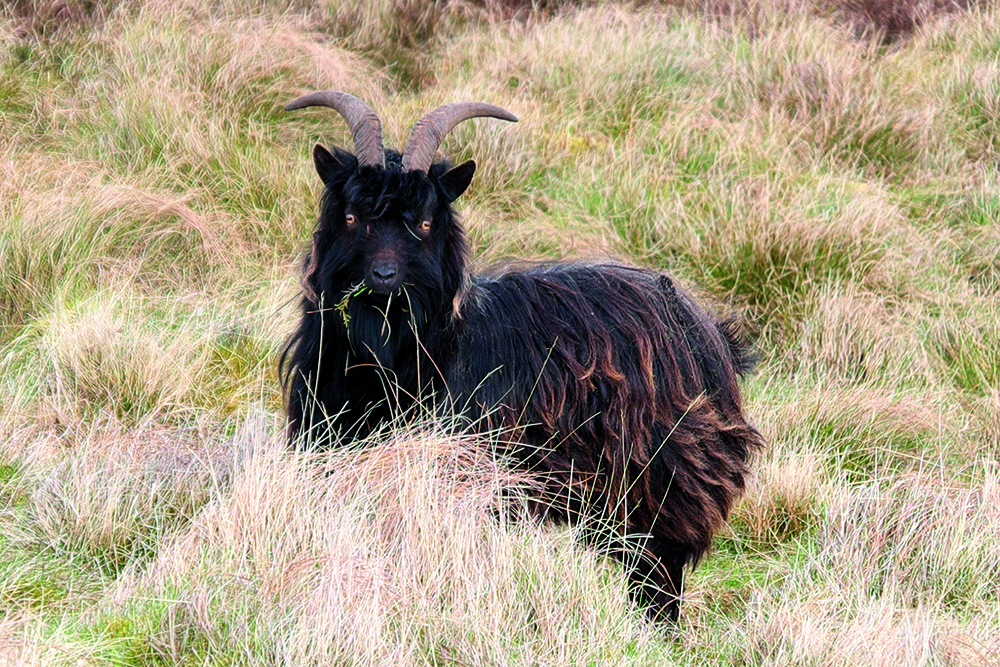Motorhome travel: Walking in Northumberland

Lindisfarne, also known as Holy Island, is connected to the mainland by a causeway that is open to vehicles for anywhere between six and nine hours at a time, depending on tides. With one of England’s most important ecclesiastical sites, a castle and an enormous nature reserve, the causeway and the island get very busy during safe crossing times. When the sea comes rushing in and the road disappears, however, the one village on the island turns into a ghost town.
When my partner, Heleyne, and I arrived, the island’s huge car park was filling up fast, so we decided to head into the dunes on the northern side of the island, leaving the more popular attractions in the south until after the causeway had closed. We walked north, constantly expecting to see the sea ‘just over the next rise’, but it was at least 15 minutes before we reached the beach. And what a beach! It stretched for miles to the west and I couldn’t see a single person on it – not even a dog walker.

As we wandered Lindisfarne’s deserted dunes and beaches, it felt like we’d entered a forgotten world. There were faint trails, but no sign of the walkers and nature-watchers who’d helped to make them. This off-the-beaten-track landscape is all part of the Lindisfarne National Nature Reserve, which covers a massive 3,500 hectares.
We were too early in the year to see the rare orchids and butterflies that thrive in the dunes and too late for the huge flocks of brent geese that fly in from Svalbard to spend the winter on the salt marshes and mudflats, but we did see a deer skipping across the sand hills, a Slavonian grebe on The Lough and a few eider ducks in the sea. These stocky, black-and-white sea ducks, famous for their soft down feathers that still occasionally plump up our duvets and pillows, have been associated with Lindisfarne for many hundreds of years. In the seventh century, St Cuthbert passed a ruling that forbade the island’s monks from eating or disturbing the birds – an edict regarded as one of the world’s first bird protection laws. Even today, the birds are sometimes known as Cuddy ducks; Cuddy being a diminutive form of Cuthbert.
A disused, grassed-over waggon way, once used to transport limestone quarried from the north coast to the industrial lime kilns near the castle, leads from the nature reserve to the south side of the island. The sixteenth-century castle, barely visible under a dense, spider web-like network of scaffolding, was closed to the public for a £3m restoration project, but the lime kilns and a tiny walled garden were still open to visitors. The latter was created in 1911 by the garden designer and writer, Gertrude Jekyll, after the renowned architect, Edwin Lutyens, had rebuilt and refurbished the castle in the Arts and Crafts style.
In the eerily silent village, with the causeway now inaccessible, most businesses had closed, but we found one café that had stayed open. Keen to continue our exploration – and rejuvenated after our coffee and cake – we headed out past the upturned herring boats in the harbour, now used as sheds by local fishermen and climbed The Heugh. This little ridge of high ground is part of the Great Whin Sill, the same narrow ridge of igneous dolerite rock on which the Roman emperor, Hadrian, built his famous wall further south. The Heugh commands excellent views over the otherwise flat island and provides a bird’s-eye perspective on the ancient priory.
The ruins seen today are largely the remains of the priory church built in 1150, but it was the Irish monk, St Aidan, who first established a monastery here in about AD635. The site is most closely associated with St Cuthbert whose body, undecayed 11 years after his death, caused the island to become a place of pilgrimage and strengthened its reputation as a place of great Christian learning. In the early part of the eighth century, the monks here created the Lindisfarne Gospels, a masterpiece of early medieval art that’s now housed in the British Library in London.

Our visit to Lindisfarne was part of a two-centre trip to north Northumberland. Our first couple of nights were spent at the South Meadows Caravan Park at Belford, just a few miles from the coast. The large, well-equipped and friendly site lies on the southern edge of the attractive village, not far from the A1. It’s a 15-minute walk from the site to the centre of Belford, which has three pubs, a café, a chippy and a decent-sized Co-op store. Even closer to South Meadows is Sunnyhills, a farm shop and café, which is open from 9am most days for excellent cooked breakfasts.
From Belford, we moved inland to Alwinton and the Clennell Hall Riverside Holiday Park – overpriced in terms of facilities, but priceless if you’re looking for a truly out-of-the-way spot to park up for a few nights. Alwinton is a tiny village in Upper Coquetdale, right in the heart of the Cheviot Hills. There’s not much here really, just a pub, some cottages and a few farms.
The road through this glorious valley goes nowhere. It winds its way upstream for 9½ miles from Rothbury to Alwinton, the last village, and then continues for another 12½ miles, climbing through the hills all the while, until it ends on the edge of the Ministry of Defence’s vast Otterburn Training Area. We drove to the end of the road one day, just to see what’s there. There’s nothing! Pennine Way hikers pass close by on the final leg of their 268-mile journey along England’s spine. Going back in time, the Romans also walked this way, but all that remains of their marching camps at Chew Green are a few lumps and bumps in the landscape.

Upper Coquetdale isn’t a place you come to for sightseeing; it’s a place either for kicking back and doing nothing or for enjoying the great outdoors. We were here for the hills. There were countless opportunities for walks from the campsite and we enjoyed four superb days exploring the area on foot. Clennell Street, referred to as the ‘great road of Yarnspeth’ in medieval documents, passes within a few hundred yards of Clennell Hall.
It’s an ancient route that used to be one of the most important thoroughfares for drovers moving cattle from Scotland to the markets of England. It crosses the border on the main, windswept ridge of the Cheviot Hills, just northeast of Windy Gyle, at a point that is nearly 1,805ft (550m) above sea level. On our first day in the area, we followed it north for 5½ miles – over rolling hills and through lonely forest – to a beautiful spot on the Usway Burn, less than two miles short of the Scottish border.
The old byway led us down to the grassy banks of the burn, just above a tiny waterfall where dippers bobbed up and down on the boulders. How could we resist such an impeccable picnic spot? After a long, leisurely lunch, we decided the Usway would make a convivial companion for our walk back to Coquetdale so, turning our backs on the border, we followed the sinuous route it had carved through the steep-sided hills all the way back to the main valley.
Other days were spent climbing to isolated Wether Cairn – on the edge of the Cheviot Hills’ heather-covered grouse moors – and exploring the area around Harbottle, Coquetdale’s penultimate village. Henry II ordered the building of a castle at Harbottle in the middle of the twelfth century to defend against the Scots. Because of its proximity to the border, the fortress saw a lot of action and was repeatedly attacked by Scottish forces, falling to them on several occasions. In 1436 it became the base of one of the wardens of the Marches, whose unenviable job it was to attempt to police the unruly border region where marauding reiver clans robbed and murdered, bringing terror to the no-man’s land between the two countries.

Now, apart from the sound of gunfire and the odd explosion from the military ranges to the south, the area is peaceful. The castle, robbed of its defensive role, is in ruins. We wandered from the village up to the Drake Stone, said, in folklore, to have the power to heal sick children. A little trail leads up to the fascinating jumble of sandstone boulders surrounding this enormous rock.
It’s an atmospheric spot – otherworldly, even. It’s not hard to see why it has a magical reputation. And what about those long lines of scratches on the sandstone? What sort of beast created those? An information panel at the base of the crags suggests they’re the result of ice action during the last glacial period, but who knows? The sense of eerie foreboding was intensified by the presence nearby of signs bluntly warning of the dangers of going off-piste on these bleak, boulder-studded moors. “
The highlight of our few days in Alwinton – other than the tasty game pie served up in the bar of Clennell Hall – was a walk along the Border Ridge. On this occasion, we woke Hamish, our campervan, from his campsite slumber and drove further up the Coquet to a spot called Buckham’s Bridge. Our only companions as we strode out along the undulating Pennine Way were the skylarks and the feral goats. These long-horned, primitive British goats live totally wild, descendants of the animals reared by early Neolithic people.
This feature was originally published in the March 2018 issue of MMM magazine. Want to read more like it? Subscribe to MMM magazine today for your monthly dose of motorhome travel inspiration.






.jpg)




Recent Updates
Engine management lights: all you need to know
What is the engine management light? What does it mean, and what do I have to do? ...
Motorhome air suspension: all you need to know
Motorhomes are heavy and the additional weight of equipment and height of the bodywork can increase the loads ...
Motorhome WiFi: how to get better motorhome internet
Staying connected on the move is more and more essential, so relying on campsite WiFi isn't an option – here ...
A class of their own - our guide to A-class motorhomes
Thinking of trading up to an A-class, or even going straight to the top of the motorhome tree? We guide you ...
Explore overseas on a motorhome dream tour
Enjoy exotic travel in a campervan or motorhome by hiring, swapping with someone else or exporting your ...
Motorhome water systems: everything you need to know
On-board water is an important part of every motorhome – here’s everything you need to know ...
Campervanning in Europe: what you need to know
Whether you're planning a leisurely drive through the French countryside, navigating bustling city streets in ...
Campervan security: all you need to know
With thefts on the increase, it’s important to know how to keep your campervan secure and prevent campervan ...
Campervan furniture: everything you need to know
Our campervan experts guide you through all the essentials for your campervan, including tables, chairs, ...
Campervan finance: how to fund your purchase
Here we look at the different types of campervan finance available, to help you decide what’s the best option ...
Other Articles
Britain’s best used motorhomes
Want a great motorhome without paying the premium for a new one? Here's a guide to the best you can get in the pre-owned market for each layout, ...
Which motorhome? Choosing the perfect motorhome for you
Choosing a motorhome or campervan is one of the biggest buying decisions you’ll ever make, so it's important ...
Campervan washroom essentials: stay fresh on the road
Our guide will take you through the campervan washroom essentials you'll need so you're well-prepared for ...
Dogs in campervans: all you need to know
Follow our advice and your dog will enjoy campervanning as much as you do ...
Electric campervans: all you need to know
Our guide will take you through everything you need to know about electric campervans and what the future ...
Motorhome electrics: a complete guide to your motorhome electrical set-up
Motorhome electrics can dramatically enhance the convenience and comfort of your vehicle – but they can be ...
Lighting for campervans: all you need to know
We guide you through all the lighting options available for you and your campervan, including interior ...
Electric bikes for motorhomes: our ultimate guide
Read our comprehensive guide to electric bikes for motorhome owners, helping you add electric power to your ...
Our guide to 'cheap' motorhomes in 2024
If you're on the hunt for an affordable new motorhome, this is the best place to start – we've rounded up a ...
Campervans in winter: all you need to know
Here's your guide to preparing your campervan for the colder months, whether you will be using it or putting ...